Wait! What?
When I present professional development seminars to fellow speech & language therapists, I always say the words you find written below:
“I have not ‘counted the stutters’ of my students for many, many years.”
When working full-time in the schools, I felt pressured to do so. Even then, I only counted stutters for initial and triennial evaluations because of the so-called "requirements." I knew that SLPs were supposed to have “data” to support our recommendations, and - at that time in the school setting - I thought that this meant fluency counts.
In fact, I felt like I had to report fluency counts for many years, until it became evident that the number of observable stutters in any specific speaking sample had no functional value for eligibility or for therapy purposes. The numbers certainly didn't have any value for crafting meaningful student communication goals.
I am keenly aware that these blunt statements may be surprising (or concerning) to some of my colleagues. But we must shake out--and cease--the historical assessment practices of valuing observable moments of stuttering more than the speaker's actual experience of stuttering.
Can we really stop counting stutters?
The short answer is "yes!" Counting stutters is not a reliable measure. We can move away from counting stutters for these primary reasons:
1. What you see is not what you get. What a listener can see or hear in a student’s speech does not capture the internal struggle or effort experienced by the person who stutters.
2. Stuttering is variable. You may have heard this phrase before: “The only consistent thing about stuttering is that it is always inconsistent.” Keeping this fact about stuttering in mind helps everyone understand that a student's feeling of "stuckness" can fluctuate significantly from moment to moment, day to day, and even situation to situation.
3. Perceived fluency can be false. During evaluations or progress monitoring sessions, when they know their therapist is counting (and yes, they know), students may subconsciously or deliberately avoid stuttering, change words, or hold back on communicating. These understandable reactions can result in artificially low counts that do not reflect a student’s everyday communication challenges.
4. Stuttering is complex. Counting stutters reduces a multifaceted communication difference to a mere number, ignoring qualitative aspects like underlying social-emotional factors that influence stuttering. Emphasizing fluency counts oversimplifies the multitude of factors that impact the speaker's experience of stuttering.
Importantly, we are not saying that communication samples have no value. Observing a student’s speech can add to the saliency of the overall stuttering assessment process by allowing us to observe a person's struggle, avoidance, circumlocutions, withdrawal, and other potential reactions. We just need to recognize that this does not tell the whole story or give the full picture. It’s just a small peek into one part of the stuttering experience.
So, by all means, continue observe your students’ speech and collect data about your own perceptions and observations as well as the perceptions and observations of others. But above all, be sure that you discover how stuttering impacts the life and communication of your students who stutter. [For more on how to do this, see the Overall Assessment of the Speakers Experience of Stuttering - OASES™]. It is incumbent on us to collect, report, and utilize relevant data that informs our recommendations and therapy planning for each individual person who stutters. Frequency counts alone just don’t cut it.
What if I am required to do "fluency counts?"
Certainly, we may have to count observable stutters when we are actually required to provide that information; however, we recommend that you not use those frequency counts in clinical decision-making. Instead, we can align our assessments with the broader understanding of what stuttering is, and how it affects students who stutter. This means that we can report the snapshot of observable stuttering behaviors, but that these numbers are not given the importance they have held in the past. Instead, we conduct comprehensive evaluations and report much more than just observable behaviors.
-------------------------------------------------------------------------------
We have written on this topic many times. Check out more resources below:
Early Childhood Stuttering Therapy: A Practical Guide
School-Age Stuttering Therapy: A Practical Guide
Related Blogs
If I don't count stutters, how can I qualify people for therapy?
Shifting Perspectives about Stuttering
Challenging Eligibility Criteria in the Public Schools
Measuring Adverse Impact in a Child Whose Stuttering Seems to be "Mild"





